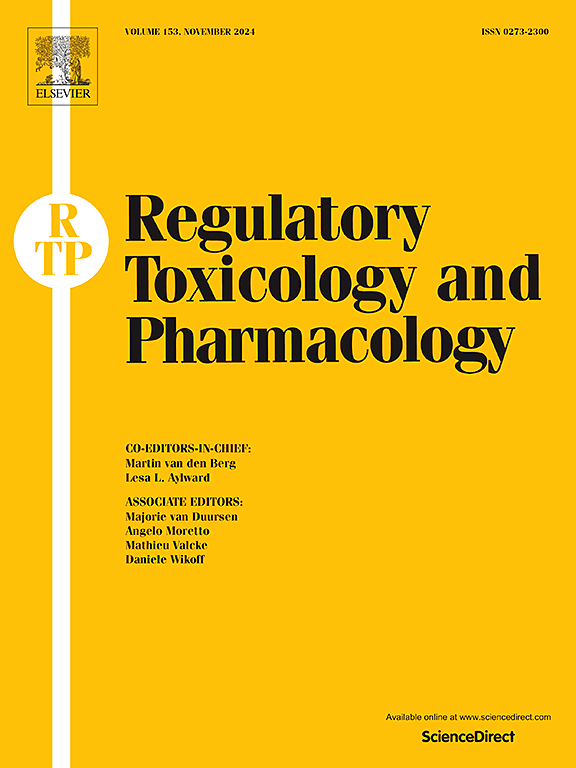Exploring the link: DNA methylation and kidney injury markers in farmers exposed to glyphosate-surfactant herbicides
IF 3
4区 医学
Q1 MEDICINE, LEGAL
引用次数: 0
Abstract
Glyphosate-surfactant herbicides (GSH), widely used herbicides, have raised concerns about their potential nephrotoxic effects. Despite extensive studies, the safety of GSH remains debatable. This study aimed to determine if occupational exposure to GSH causes detectable changes in renal injury biomarkers—specifically DNA methylation, KIM-1, TIMP2, and IGFBP7—in farmers regularly exposed to these chemicals. Two urine samples, pre-task (0-h) and post-task (24-h), were collected to analyze these biomarkers. No significant immediate changes were observed post-exposure, possibly due to personal protective equipment use. Moderate positive correlations were found between IGFBP7 and KIM-1, and IGFBP7 and TIMP2, suggesting early kidney injury. About 50% of subjects had a biomarker ratio greater than 1, indicating increased levels of IGFBP7, TIMP2, and KIM-1 after GSH exposure. This indicates that farmers who regularly spray GSH are at high risk of exposure, potentially leading to significant renal injury. Further long-term studies are needed to assess the chronic effects and validate these biomarkers for monitoring renal health in populations exposed to glyphosate.

探索联系:暴露于草甘膦表面活性剂除草剂的农民的DNA甲基化和肾损伤标志物。
草甘膦表面活性剂除草剂(GSH)是一种广泛使用的除草剂,其潜在的肾毒性引起了人们的关注。尽管进行了广泛的研究,谷胱甘肽的安全性仍存在争议。本研究旨在确定职业暴露于谷胱甘肽是否会导致经常暴露于这些化学物质的农民肾损伤生物标志物的可检测变化,特别是DNA甲基化,KIM-1, TIMP2和igfbp7。收集任务前(0-h)和任务后(24小时)两份尿液样本,分析这些生物标志物。接触后未观察到明显的立即变化,可能是由于使用了个人防护设备。IGFBP7与KIM-1、IGFBP7与TIMP2呈中度正相关,提示早期肾损伤。约50%受试者的生物标志物比值大于1,表明GSH暴露后IGFBP7、TIMP2和KIM-1水平升高。这表明,经常喷洒谷胱甘肽的农民暴露的风险很高,可能导致严重的肾脏损伤。需要进一步的长期研究来评估草甘膦暴露人群的慢性影响,并验证这些生物标志物监测肾脏健康的有效性。
本文章由计算机程序翻译,如有差异,请以英文原文为准。
求助全文
约1分钟内获得全文
求助全文
来源期刊
CiteScore
6.70
自引率
8.80%
发文量
147
审稿时长
58 days
期刊介绍:
Regulatory Toxicology and Pharmacology publishes peer reviewed articles that involve the generation, evaluation, and interpretation of experimental animal and human data that are of direct importance and relevance for regulatory authorities with respect to toxicological and pharmacological regulations in society. All peer-reviewed articles that are published should be devoted to improve the protection of human health and environment. Reviews and discussions are welcomed that address legal and/or regulatory decisions with respect to risk assessment and management of toxicological and pharmacological compounds on a scientific basis. It addresses an international readership of scientists, risk assessors and managers, and other professionals active in the field of human and environmental health.
Types of peer-reviewed articles published:
-Original research articles of relevance for regulatory aspects covering aspects including, but not limited to:
1.Factors influencing human sensitivity
2.Exposure science related to risk assessment
3.Alternative toxicological test methods
4.Frameworks for evaluation and integration of data in regulatory evaluations
5.Harmonization across regulatory agencies
6.Read-across methods and evaluations
-Contemporary Reviews on policy related Research issues
-Letters to the Editor
-Guest Editorials (by Invitation)

 求助内容:
求助内容: 应助结果提醒方式:
应助结果提醒方式:


